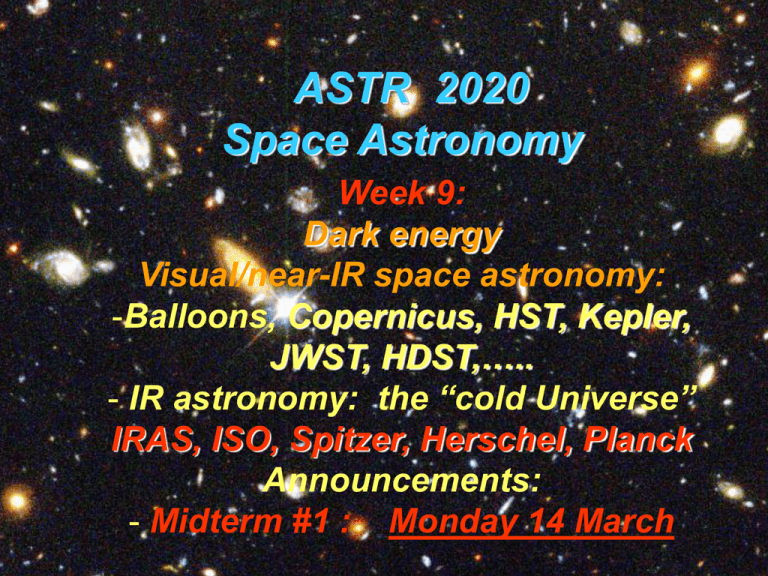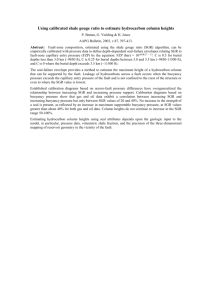ASTR 2020 Space Astronomy Week 9: IRAS, ISO, Spitzer, Herschel, Planck
advertisement

ASTR 2020 Space Astronomy Week 9: Dark energy Visual/near-IR space astronomy: -Balloons, Copernicus, HST, Kepler, JWST, HDST,….. - IR astronomy: the “cold Universe” IRAS, ISO, Spitzer, Herschel, Planck Announcements: - Midterm #1 : Monday 14 March Three “cornerstones” of Modern Cosmology: • Expansion of the Universe (Hubble) V=HD • H ~ 71+/- 3 km/s Mpc-1 Abundances of the elements H, He => “Big Bang” all else came from => “stars” • Cosmic Microwave Background Universe was smooth to 2 parts 105 13.7 Gyr ago, ~ 400,000 years after the Big Bang Goals of Visual, near-UV, near-IR Space Astronomy: • Get above atmospheric turbulence: Better than 1” ! Lyman Spitzer’s vision (late 1950s … a large space telescope) 0.35 m < < 2.4 m • Probe Universe without atmospheric obscuration: < 0.35 m (3,500 Angstroms) UV absorbed by electronic transitions … > 2.4 m (3,500 Angstroms) water, CO2, OH airglow, black-body radiation ASTR 2020 Space Astronomy Week 9: Dark energy Visual/near-IR space astronomy: -Balloons, Copernicus, HST, Kepler, JWST, HDST,….. - IR astronomy: the “cold Universe” IRAS, ISO, Spitzer, Herschel, Planck Announcements: - Midterm #1 : Monday 14 March Major Visual, near-UV missions: • Project stratoscope (36” on a balloon at 100,000 feet) • Copernicus UV satellite (1972 - 1981) spectra • International Ultraviolet Observatory (IUE; 1978 - 1996) spectra • Hubble Space Telescope (HST; 1990 - present ) • Far Ultraviolet Spectroscopic Explorer (FUV spectra) (FUSE; 1999 - 2007) • Galaxy Evolution Explorer (UV imaging) (GALEX; 2003 - 2013) • • Hipparcos (1989 - 1993) Astrometry GAIA (2013 - present) Astrometry Hubble Space Telescope HH 46/47 HH 46/47 NTT [OII] Ha [SII] m HH 46/47 HH 46/47 Spitzer (Noriega-Crespo 04) H2 PAH 3.6, 4.5, 8 m HH 46/47 2.6 mm CO J=1-0 contours Arce et al. 2013 HH 46/47 (Hartigan et al. 05, AJ) Balmer filaments HST 1994 HH 46/47 (Hartigan et al. 05, AJ) Balmer filaments HST 1997 NGC 2024 Horsehead Nebula Orionis (OB 1 c) NGC 1981 (OB 1 c) (OB 1 d) NGC 1977 Orion Nebula Ori NGC1980 Source of Col + AE Aur Disks & planet formation: Smith, Bally, Licht, Walawender 05 d253-535 in M43 Young Proto-planetary Disk Orion B NGC 2068 LkHa 212/213 LkHa 312/ 313 HH 24 Ha [SII] B. Reipurth / Subaru N-Body dynamics: > 6 YSOs + jets HH 24 Ha [SII] B. Reipurth Subaru Wide-Field Infra-Red Survey Telescope (WFIRST) 2.4 meter primary (surplus from DOD) James Webb Space Telescope 6.5 - meter diameter Earth-Sun L2 (~106 km from Earth): 2018 James Webb Space Telescope (model) James Webb Space Telescope (model) James Webb Space Telescope (deployment & orbit) ASTR 2020 Space Astronomy Week 9: Dark energy IRAS, ISO, Spitzer, Herschel, Planck Announcements: - Midterm #1 : Monday 14 March Exoplanets are DIM Exoplanets are DIM Finding another Earth: visual spectra Finding another Earth: near-IR spectra Starshade: Exo-planets Use with WFIRST ? Future Telescopes: WFIRST, 2.4 meter primary James Webb Space Telescope, 6.5 m High-Definition Space Telescope, 11.7m High-Definition Space Telescope, 11.7m Major Infrared missions: Need for cryogenic cooling ! (Liquid Helium ….) • Infrared Astronomy Satellite (IRAS; 1983) • Infrared Space Observatory (ISO; 1995 - 1998) • Akari (Astro-F; 2006 - 2011) • Midcourse Space Experiment (MSX; 1996 - 1997) • Spitzer Space Telescope (Spitzer; 2003 - present) • Submillimeter Wave Astronomy Satellite (SWAS; 1998 - 2005) • Wide-field Infrared Survey Explorer (WISE; 2009 - 2013) Herschel Space Observatory / Planck (2009 - 2013) • Herschel Space Observatory: (May 2009 - April 2013) D = 3.5 meter @ L2 PACS: 70, 100, 160 m SPIRE: 250, 350, 500 m HIFI: THz heterodyne Herschel Galactic Plane Survey (Hi-GAL) Our Milky Way @ visual wavelengths Our Milky Way @ near infrared wavelengths Our Milky Way @ far infrared wavelengths Distant galaxies: 1 Billion years ago: distant galaxies @ near-IR wavelengths Cosmic Microwave Background: Snapshot of 3,000 K plasma when Universe was 300,000 yrs old Redshifted by Expansion of the Universe x1,000 => 3 K Bania’s Clump 2 l = 1.3 Sgr B2 / B1 Sgr A Sgr C 24 m (Hinz 2008; Yusef-Zadeh 2009) Bania’s Clump 2 l = 1.3 Sgr B2 / B1 70 m Sgr A Sgr C Bania’s Clump 2 l = 1.3 Sgr B2 / B1 Sgr A 160 m Sgr C Bania’s Clump 2 l = 1.3 Sgr B2 / B1 Sgr A 250 m Sgr C Bania’s Clump 2 l = 1.3 Sgr B2 / B1 Sgr A 350 m Sgr C Bania’s Clump 2 l = 1.3 Sgr B2 / B1 Sgr A 500 m Sgr C Bania’s Clump 2 l = 1.3 Sgr B2 / B1 Sgr A Sgr C 1100 m (Bolocam Galactic Plane Survey Ginsburg et al. 2012) Bania’s Clump 2 l = 1.3 Sgr B2 / B1 Sgr A Sgr C 20 cm (Yusef-Zadeh 2009) Bania’s Clump 2 l = 1.3 Sgr B2 / B1 Sgr A Sgr C 24 m (Hinz 2008; Yusef-Zadeh 2009) Bania’s Clump 2 l = 1.3 Sgr B2 / B1 70 m Sgr A Sgr C Central Molecular Zone 24 m, 70 m, 350 m Central Molecular Zone 24 m, 70 m, 350 m Central Molecular Zone 20 cm, 70 m, 350 m Central Molecular Zone 20 cm, 70 m, 350 m Central Molecular Zone 20 cm, 70 m, 350 m 24 m 350 m 2/3 gas, dust: @ Pos. longitudes 2/3 24 m sources: @ Neg. longitudes 1o => R ~ 150 pc, torbit ~ 8 Myr Sgr B2 Inert, stable CMZ Sgr A* Starburst region Sgr B2 Sgr B1 8 m 70 m 350 m G0.25 GCB 50 km/s Sgr A 20 km/s Central Molecular Zone 20 cm, 70 m, 350 m Galactic Center: 20 cm Sgr A (CNR) N(H2) from dust (Rome algorithm) Sgr A (CNR) Tdust cold ~ 14 K warm ~ 50 K (Rome algorithm) Sgr A (CNR) Galactic Center: 8 m Sgr B2 Sgr A (CNR) Galactic Center Bubble: 24 m Sgr A (CNR) Sgr A (CNR) 8 m 70 m 350 m Galactic Center: 20 cm Sgr A (CNR) Galactic Center Bubble => Sofue-Handa Lobe => Fermi-LAT Bubble ? Finkbeiner et al. (2010) SofueHanda Lobe 3.5 cm (GBT) 2 deg. Law et al. (2009, 2010) Caution: Sco-Cen superbubble 150 pc from Sun The Fate of the Visible Universe Hubble constant: expansion rate NOW DARK MATTER: pulls expansion curves down DARK ENERGY: pushes expansion curves up Redshift: z= obs - em em Cosmic Microwave Background SPACE missions • COsmic Background Explorer (COBE) 1989 - 1993 Differential Microwave Radiometer Far-InfraRed Absolute Spectrophotometer Diffuse InfraRed Background Experiment • Wilkinson Microwave Anisotropy Probe (WMAP) 2001 - 2010 • Planck 2009 - 2013 Cosmic Microwave Background (COsmic Background Explorer - COBE) 2.728 K Black Body Remove constant background (2.728 K): Solar motion at ~600 km/s toward Virgo (Doppler shift) Cosmic Microwave Background (CMB) Remove Solar motion “CMB” + Galactic Plane dust Remove model of dust emission => True CMB Cosmic Microwave Background (Wilkinson Microwave Anisotropy Probe - WMAP) Snapshot of the Universe when it was 380,000 yrs old Then: 1/2 temperature of Sun’s surface: (13.7 billion years ago!) Today: 3 C above absolute 0! Dark Energy • Type Ia supernovae: => Explosions of 1.4 Solar mass white dwarfs accreting from companion => `Standard candle!’ => Dimmer (farther) then expected from redshift => Expansion of Universe accelerating ! (since 5 – 10 Billion years ago) • Cosmic Microwave Background: => `Standard Ruler’! => Geometry of Universe is flat => Requires more than ordinary matter (4%) dark matter (26%) Dark energy: tension in the vacuum! (70%) Matter dilutes; dark energy is constant as volume grows: Black holes: Escape speed = speed of light R = 2 GM / c2 ~ 3 km/s x Mass(Solar masses) Stellar mass black holes: M = 1 to 100 Mo Remnants of core collapse supernovae of stars with initial mass M > 30 Solar masses Intermediate-mass black holes: Centers of Globular clusters ? Super-massive black holes: In centers of Galaxies: 106 - 1010 Mo Mini black holes? Formed in Big Bang? Minimum mass due to Hawking radiation Active Galactic Nuclei (AGN) - Quasars - Seyferts - Radio galaxies The History of our Universe

